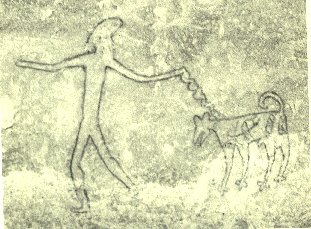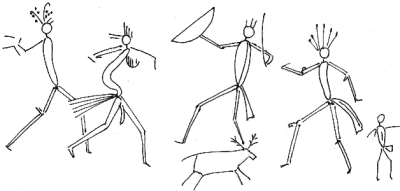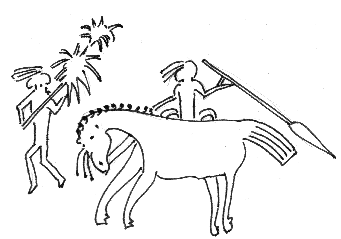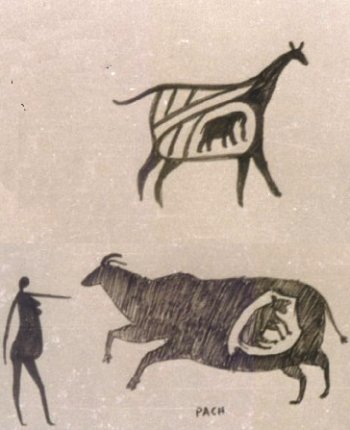Prehistoric Rock Paintings of Bhimbetka
by Dr. K. L. Kamat
First Online: August 15, 1997
Page Last Updated: December 07, 2024

Hunting a deer
Notice the grass in the deer's stomach.
When I reached Bhimabetaka (a.k.a. Bhimbetka and Bhimabetaka) 40 kilometers south of Bhopal, I felt as if I discovered treasure mine of prehistoric art. I admired the location our ancestors had chosen for the art studio. Surrounded by evergreen forest and about 50 or 60 small hillocks, this place has remained a landmark of generations of prehistoric art. It is believed that these paintings are twenty thousand to fifty thousand years old. There are residues of Brahmi scripts which are considered extremely ancient. In the later years, king Bhojraj liked this location and started building a fitting temple of Shiva and the lake. For some reason, the construction never finished. Today the lake provides for excellent agriculture in the neighborhood and the Bhojpur temple attracts devotees even from far distances.
 These rock paintings mirror
the difficulties and triumphs of the native man. These rock paintings mirror
the difficulties and triumphs of the native man. |
The Bhimabetaka hillocks are made of sandstone. They are elevated from the valley and are ideal for human habitat. There are some caves, but most are natural havens. The natives must have used bamboo and mud for construction of walls and steps and the constructions must have died along with them. It is easy to tell that these habitats were part of community as in Ajanta and Ellora. There are stages and animal sheds, small and big. Bhimabetaka remains a great witness to the evolution of mankind's civilization, through its numerous rock weapons, tools, ceramics, and bones. More than anything else, the rock paintings are the greatest wealth the natives of Bhimabetaka left behind.
© K. L. Kamat

Pet or tool ? Man walks a dog
Rock Painting, Madhya Pradesh
The students of these rock paintings must take to some adventure. Due to the constant battering of nature and mankind the foundations of art treasures has collapsed and it is not easy to get to the top. It is common for peacocks and bats to dwell in these havens, but sometimes one might run into porcupines, bear, or poisonous snakes, and one has to very careful every step. The caves are typically pitch dark and takes time to locate any paintings on their walls. Sometimes the paintings are located at the entrance, but those interior are in much better shape because of protection from rain. Some native artists were truly adventuresome and it takes a lot of effort even to get to some of the paintings. Long before the days of commercial elevators people had to be able to climb. Disabled visitors who are dependent on elevators should be aware of this when visiting Bhimabetaka.
© K. L. Kamat

Encircling the prey
I do not believe these paintings were drawn either to decorate to caves or to find entertainment. They were created as a means of escape from suffering and as devotion to supernatural entity. Most of them are not planned or organized nicely. Some have not taken the trouble to erase older paintings before drawing the new ones on them. In a few spots, I found four or five layers of sketches on top of another. The colors and the styles of such layers, however, are different and have enabled the experts to separate one from another. There are red, green, and white colors in all hues and varieties. The same pigments were used to decorate the dead and it is common to find these colors in funeral spots also. The paintings were done primarily with a finger, but I believe that they must have used feathers, wooden sticks, and needles of porcupines for different styles and textures.
Since the native man was not bound by any artistic constraints, the pictures come to life in full freedom and expression. The native man was an expert in simplifying life; he has drawn animals and birds with just two or three strokes. He has also made a good use of symbols and highlights, so a trunk denotes an elephant, a long feather represents a peacock, and a decorative horn illustrates a female deer. Some are single line sketches, and some are finished with a fair stroke. Some are really attractive with colors and shades.
© K. L. Kamat

Welcome to a Hero
The background of the rock paintings is obscure and is hard to photograph the paintings. Most of them have lost the sharpness and luster. Some are extremely fuzzy and ruined. I had to use special contrast film and filters to photograph them. I could have sprayed the water on them for better contrast, but the water with its alkaline contents damage the originals, and there was no way for me to carry chemicals and other gear to that remote location. I have taken the easy route out and have drawn the line drawings in this page based on my photographs. When compared to originals these pictures may look artificial, yet I hope that they resemble the originals as perceived by the original artists.
© K. L. Kamat

Imagination or Ignorance?
The ancient artists cared little for the details. Like the modern artists, it must have been the feeling to be conveyed was the most important for him. I also feel that he has done great injustice to the women of his time. Among the thousands of pictures, less than ten show women. In this aspect, the rock paintings of Bhimabetaka differ from the cave paintings of Spain which are about of the same period. Since the Spanish painters were desiring renewal of life, the sexes and the organs are given primary importance. Few Bhimabetaka paintings show sexual organs. Sometimes to identify a woman they have drawn a small vagina, but has left out the breasts. However, in some spots to glorify women they have drawn large breasts with fountains of milk coming out of them.
These rock paintings mirror the difficulties of the native man's struggle with life as also his accomplishments. You can see rock weaponry, bows, arrows, and then the knives. He wove baskets with bamboo and started climbing the trees. He learned how to weave a rope from tree bark and cloth from the fibers. He must have used fish bones as needle and trained dogs for hunting. About this time he also learned raising of birds for food.
As the civilization progressed there were fights among tribes. There are lots of pictures in Bhimabetaka which illustrates ferocious warfare among humans. Since there are no signs of horses in the neighborhood of Bhimabetaka, the ones in the picture were probably confiscated from raiding invaders.
© K. L. Kamat

Group dance
After the daily life became easier, the native man turned to dancing in music. There are pictures of group dance, mask dance, and stick dance. Although it's a common concept that the native man was naked, the artist has drawn clothes on all the dancers. It's possible that the clothing was unisex.
As a person who went to find the similarities between current day tribals and native tribals, I was dumbfounded by the similarities in their lifestyle. The tribals of Madhya Pradesh have lived monotonous lifestyles for thousands of years. Even today the Adivasis (aa-di-vaa-si, from Sanskrit, native) draw animals and birds on their walls consisting of triangles and circles for success in hunting. They also have unisex clothing, hunting with bows and arrows, and group dances. If someone studies the similarities between the two cultures, several generations of lost lifestyles may be uncovered.
![]()
References
- Kamat K.L., The Timeless Theater CD-ROM, 1999 (Buy at Amazon)
- Brooks, R. and Wakankar V. S., Stone Age Painting in India, Yale, 1976
- Kamat K. L., KaalaRanga (in Kannada), Manohara Grintha Mala, 1982
See Also:
- The Arts of India -- numerous art forms form Indian subcontinent
- Kamat PictureSearch Results for Cave Art
- Bastar Travelogue -- Life among tribals of Madhya Pradesh
- The Tribals of India
- Prehistoric Rock Paintings from Central India - Index
- Man Who Found Saraswati River -- Accidental encounter with Prof. V.S. Wakankar in the archeological site of Bhimabetka.
Prehistoric Cave Paintings of Bhimabetaka
Introduction | Artistic Merits
Picture Galley | Other
Prehistoric Art from India
